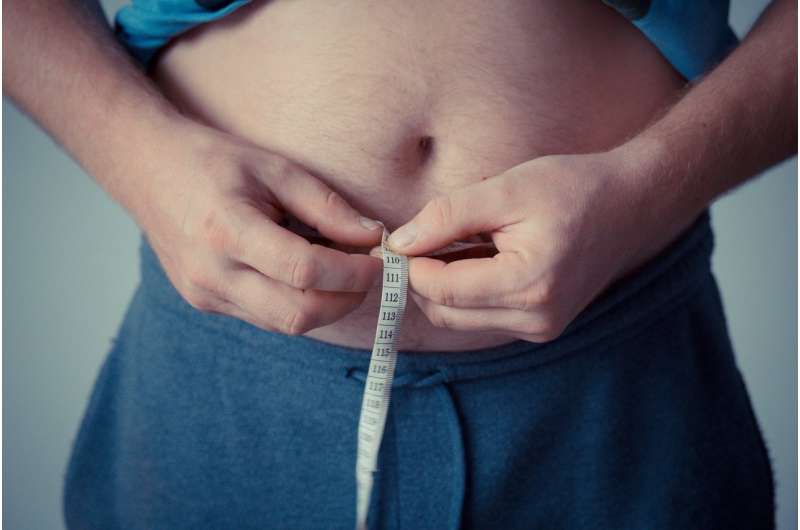Warning labels can help reduce soda consumption and obesity, new study suggests

Labels that warn people about the risks of drinking soda and other sugar-sweetened beverages can lower obesity and overweight prevalence, suggests a new Johns Hopkins Bloomberg School of Public Health study.
The study used computer modeling to simulate daily activities like food and beverage shopping of the populations of three U.S. cities – Baltimore, San Francisco and Philadelphia. It found that warning labels in locations that sell sugary drinks, including grocery and corner stores, reduced both obesity and overweight prevalence in the three cities, declines that the authors say were attributable to the reduced caloric intake. The virtual warning labels contained messaging noting how added sugar contributes to tooth decay, obesity and diabetes.
The findings, which will be published online December 14 in the American Journal of Preventive Medicine, demonstrates how warning labels can result in modest but statistically significant reductions in sugary drink consumption and obesity and overweight prevalence. Study results show a reduction in obesity prevalence by 1.69 percent and overweight prevalence by 1.39 percent in Baltimore, 4.08 percent and 3.1 percent in San Francisco and 2.17 percent and 0.36 percent in Philadelphia. Variations between cities may be in part due to the different proportion of obese and overweight inhabitants in the cities as well as different distributions of BMI (body mass index), the researchers say. While this intervention has a positive impact on obesity and overweight prevalence, it is not the sole solution to the obesity epidemic, as addressing many other factors is key.
"We found that sugary-drink warning labels may help decrease obesity and overweight prevalence across a wide variety of circumstances," says Bruce Y. Lee, MD, MBA, lead author and executive director of the Bloomberg School's Global Obesity Prevention Center. "A warning label is able to decrease a person's chance of purchasing a sugary beverage by 4 percent, when nearly half of children cannot read the labels or when many people replace drinking soda with eating more."
Research suggests that sugary-drink consumption contributes to the rising obesity epidemic, especially among children. Sugary drinks can be a source of empty calories, calories that do not provide much nutritional value. According to the National Health and Nutrition Examination Survey data from 1988-1994 and 1999-2004, daily calories consumed from sugary beverages increased by 20 percent among 6- to 11-year-olds during those time periods.
Cities have been looking for ways to reduce sugary-drink consumption. In the spring of 2015, San Francisco passed an ordinance mandating the placement of sugary-drink warning labels in locations that sell sugary beverages. Other municipalities, including Baltimore, have considered passing similar ordinances.
For the study, a research team from the Global Obesity Prevention Center and the Pittsburgh Supercomputing Center developed detailed computational simulation models, called Virtual Populations for Obesity Prevention of three cities: Baltimore, San Francisco and Philadelphia. Like the computer game "SimCity," these models included virtual representations of each person, the combined populations of the three cities and each potential major food and beverage source (e.g., grocery stores, corner stores, convenience stores and schools) in the given city.
Over the course of a simulated day, the different virtual people in the models would go about their daily business, periodically stopping at different food and beverage locations. At a given location, a person could either purchase a sugary drink or an alternative unsweetened drink such as water. Data for this model came from various sources including the U.S. Census Bureau, the National Health and Nutrition Examination Survey and ReferenceUSA.
Experiments then explored the effects of placing warning labels at different locations that sell sugary beverages, such as supermarkets, corner stores and restaurants. Study researchers tested warning labels that would change the virtual customer's decision to purchase a non-sugary beverage instead of a sugary beverage between 4 percent and 12 percent of the time. Even when labels were 4 percent effective, they reduced obesity prevalence by 1.08 percent in Baltimore. Scenarios reducing the proportion of literate adolescents in Baltimore to 51 percent continued to demonstrate health benefits – when labels were effective 8 percent of the time, there was a 0.95 percent reduction in obesity prevalence. Scenarios also simulated lower label effectiveness among low-income populations and continued to see benefits of the warning label.
Results from the study showed that the implementation of sugary-drink warning labels at all retailers significantly lowered obesity prevalence among adolescents in all three cities.
"This study also highlights the importance of warning label design," says Marie C. Ferguson, MSPH, research associate at the GOPC. "Efforts to increase readability and incorporate memorable visuals may increase warning-label efficacy and ultimately promote an even greater impact."
Results from this study could help policymakers and other decisionmakers understand the potential effects of implementing sugary-drink warning labels. Computer modeling helps to design and test sustainable interventions and policies with the "safety" of a computer before rolling them out in real life, thus saving considerable time, money and effort. Given that a city has a limited budget or are only able to implement the policy in certain locations, results from the study suggest that they ought to target supermarkets. At 8 percent warning-label efficacy, the intervention implemented only at supermarkets reduced overweight and obesity prevalence by 0.94 percent in Baltimore, 0.41 percent in San Francisco and 0.85 percent in Philadelphia. When the intervention only targets small grocers, the overweight and obesity prevalence reduction is less: 0.73 percent in Baltimore, 0.29 percent in San Francisco and 0.57 percent in Philadelphia.
"A single intervention or single policy is not going to be enough to curb the obesity epidemic or the childhood obesity epidemic," says Lee. "Combinations of different policies and interventions will be necessary. Our results suggest that SSB warning labels could be a helpful part of these combinations."
More information: Bruce Y. Lee et al. Simulating the Impact of Sugar-Sweetened Beverage Warning Labels in Three Cities, American Journal of Preventive Medicine (2017). DOI: 10.1016/j.amepre.2017.11.003
















